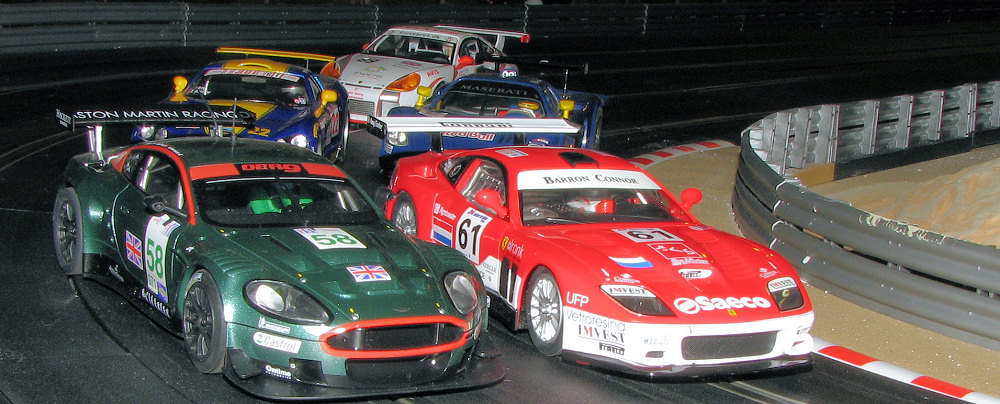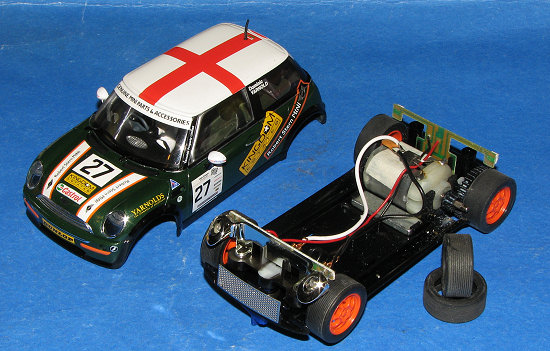 IN
IN THE GROOVE
̺
IN
IN THE GROOVE
̺  IN
IN THE GROOVE
̺
IN
IN THE GROOVE
̺
Welcome to a new feature I’d like to call ‘In the groove’. I thought it would be not only appropriate since this will be about slot car racing, but the title is also corny as well.
Many of you are probably thinking, “Huh? What’s this have to do with scale modeling?” Well the truth is that the majority of slot car racing today, tries to keep as true to scale as is possible. As an auld phart who used to race and win quite regularly in this hobby back in the late 1960s, when I saw the detail that was put into modern slot cars today, I was extremely impressed. They look like motorized models as done from a kit.
A bit of history. (Clearing of throat). Back when the hobby first started, it was designed for kids to buy a set with track, two controllers, two cars and a power supply. One then spent time assembling the track on the floor, plugging things in and going for it. My first home track was a Strombecker track with a D-Jaguar and Ferrari Testa Rossa. The one piece semi-rubber bodies snapped onto a plastic chassis that held an open in-line motor that operated plastic gears and had plastic wheels with rubber tires. Performance was enough for the tracks of the time and the cars were able to handle a lot of punishment.
Strombecker tracks were not the best but the Scalextric ones from England were and I upgraded to that, adding more cars.
Eventually, ‘professional’ tracks opened up and we usually begged and pled with our parents to take us there and drop us off for a Saturday afternoon of racing. Those establishments catered more to faster, 1/24 scale cars than the 1/32 scale ones that were the norm for a home track.
As time progressed and I got better at it, I started buying only cars that would run on the pro tracks and equipment started getting more expensive. The home track went into attic storage. When old enough to drive, I stopped bugging my parents for a lift and went with like-minded friends. Then we started visiting other tracks, entering large and long races and so on it went. I left the hobby at its heights as other things interfered and so my equipment and old track lay moldering in the attic for nearly 40 years.
Move ahead to 2007. Through a sequence of events that I still don’t fully understand, the interest was rekindled. I’ll blame a review book I did last year on slot cars and the receipt of a copy of Scale Auto Racing. This tied in with my buying some clear bodies from a nice couple at the Quad Cities show and the bug had bitten.
Within a month I’d bought some used track from Evil-Bay and also grabbed some particle board and built a base for a track in the basement. It now measures 75 feet or so as that is all I could squeeze into 16 x 6.5 feet, the space I had available. This is all 1/32 scale and provides quite a bit of enjoyment as I work to improve the look of the setup.
So enough about how I got involved back into an old childhood hobby.
What’s the hobby like today?
From what I have read, there are areas of the country where it is still going strong. Chicago and the West Coast seem to have quite a following with many commercial tracks in operation. Here in the St. Louis area, this isn’t true with none that I’m aware of.
So most of the interest is in what is frequently called ‘Euro-scale’. This is because the majority of new 1/32 slot cars are from European companies (though most are made in China). Without getting into specifics, almost all the different brands from Scalextric, Arin, Carrerra, Revell, Fly, Slot-it, Spirit and so on produce very nicely done scale cars with good detail. Prices for ready to run cars are generally from about $40 on up to some I’ve seen for several hundred. I tend to stay at the bottom end of that spectrum and get cars when they are on sale to save money.
 So
let’s take a look at a typical slot car of 2007. This is a Scalextric
Mini-Cooper and retails for about $44.00. It is made in China is superbly
painted and is so designed to have a lot of interior detailing as well. This
includes a nearly full figure driver. Looking on the underside, we can get an
idea of how such a nice interior can be added. You can see in the underside
image that the power to reach the motor goes through two pieces of braided wire,
something which has been pretty well standard stuff for large
So
let’s take a look at a typical slot car of 2007. This is a Scalextric
Mini-Cooper and retails for about $44.00. It is made in China is superbly
painted and is so designed to have a lot of interior detailing as well. This
includes a nearly full figure driver. Looking on the underside, we can get an
idea of how such a nice interior can be added. You can see in the underside
image that the power to reach the motor goes through two pieces of braided wire,
something which has been pretty well standard stuff for large r
scale slot cars since the first ones were developed. The guide ‘shoe’ has a tab
on it that fits into the slot in the track, hence the term ‘slot car’. The
guide on this particular car has a range of about 45 degrees to each side. Other
cars may have even wider ranges of movement.
r
scale slot cars since the first ones were developed. The guide ‘shoe’ has a tab
on it that fits into the slot in the track, hence the term ‘slot car’. The
guide on this particular car has a range of about 45 degrees to each side. Other
cars may have even wider ranges of movement.
Removing the body, we can see the
inside electronics and mechanical features. This particular car has operating
head and tail lights which are really LEDs. Somewhat unlike your automobiles,
the only time these lights are on is when
 power is being fed to the car.
When you let off the hand throttle for the corners, the lights go out. Some
brands incorporate capacitors that keep a small charge stored and so the lights
stay on a bit longer when they are not receiving power, such as coasting through
turns.
power is being fed to the car.
When you let off the hand throttle for the corners, the lights go out. Some
brands incorporate capacitors that keep a small charge stored and so the lights
stay on a bit longer when they are not receiving power, such as coasting through
turns.
The design of this car is what is known as a ‘sidewinder’ set-up. That is because the electric motor is in the chassis side to side and drives a spur gear. Other set-ups include having the motor at a 45 degree angle, and ‘anglewinder’ set up, and having the motor run fore and aft, driving a crown gear; an ‘in-line’ set up. None is really superior though my preference is for the sidewinder types as this greatly reduces troubles with gear mesh.
You will also notice that there is a small rectangular bar in front of the motor. This is something that is quite new to me since returning to the hobby and it is a magnet. The idea is that the magnet is attracted to the metal power rails aside the slot in the track and these help improve cornering speed. In fact, they can be so strong as to basically prevent the car from leaving the slot at all. To me, this is not fun and takes away any skill needed to race these cars. So none of the cars I race have strong magnets in them and I can see a time when I may very well remove the magnets altogether.
As with any hobby item, there is a burgeoning aftermarket. One is for more powerful magnets, faster motors, and for replacement tires. All the tires on these cars are rubber ones that slip over the plastic wheel. Rubber is fine, but does not provide the best traction on a plastic track. What does is silicone, and many of my cars, including this one, have replacement silicone tires. They are not as detailed as the ones that come with the car, but provide much better traction in the turns than the rubber ones. On my track and on this car it is around a 1 second faster lap time. Downside is that they cost about $5 a pair, they make more noise when running and they are a bit heavier than the stock tires. However, I find it worth it in having a car that slides a bit less and seems to stay in the slot a bit better.
In case you are wondering, these cars can take a tremendous beating. I’ve had them fly off the track and smack a concrete floor with little more than a small scuff. The bodies are made of high impact ABS plastic and when they say high impact, they mean it. If a part comes loose (as they often do), I use RTV to put them back into place. This holds them in well enough and yet isn’t so rigid as to cause the mounting pins to easily snap.
So there you have it, a long winded introduction to the hobby and how I got back into it. I’m not really sure where it will go from here so feedback would be appreciated.
Hope to see you again in the near future and if you’d like to share some of your experiences or photos of your cars or track, please e-mail me at mmreaders@aol.com. I can’t promise to get back to you quickly or that your images will be published, but who knows!
July 18, 2007
Scott